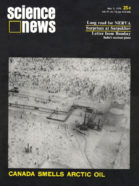
Superconductivity under pressure, Science News, May 2, 1970 –
Cooling certain metals to temperatures near absolute zero turns them into superconductors, substances without electrical resistance, in which currents flow without power loss. In recent years it has become apparent that in some cases pressure as well as cooling has something to do with inducing superconductivity. Metals are found that are not superconducting under normal pressure but become superconducting under both pressure and cooling.
Update
Extreme pressures can produce superconductors that work at higher temperatures than any other materials known, recent studies reveal. Squeezed to more than a million times Earth’s atmospheric pressure, hydrogen sulfide is a superconductor at up to 203 kelvins (−70° Celsius), and a superconductor of lanthanum and hydrogen reportedly works at a record-breaking 260 kelvins (−13° C). Scientists hope to find a superconductor that doesn’t require pressure or cooling. That could revolutionize electronic devices and reduce energy losses in the power grid.
Source: Physics - www.sciencenews.org



